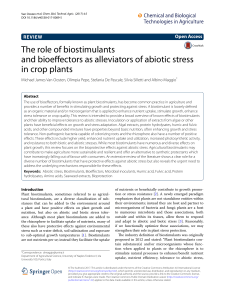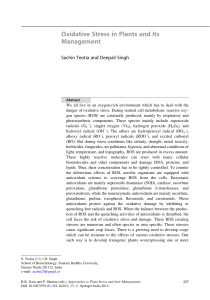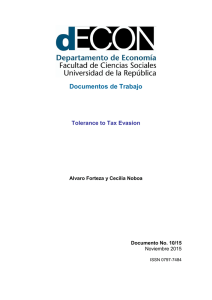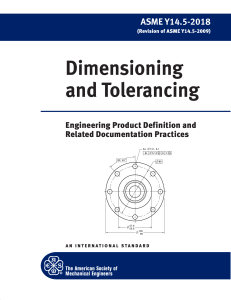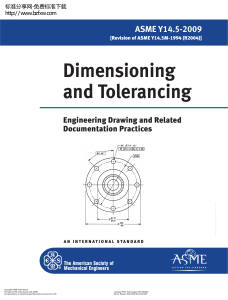Standars and Calibrators
Anuncio
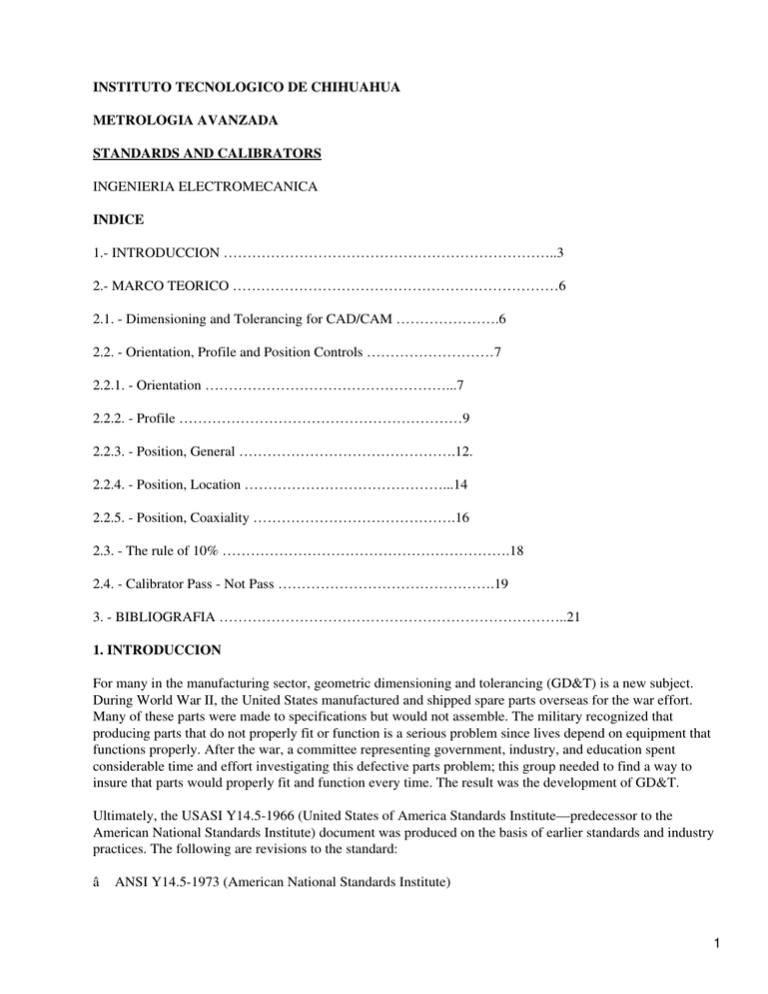
INSTITUTO TECNOLOGICO DE CHIHUAHUA METROLOGIA AVANZADA STANDARDS AND CALIBRATORS INGENIERIA ELECTROMECANICA INDICE 1.- INTRODUCCION ……………………………………………………………..3 2.- MARCO TEORICO ……………………………………………………………6 2.1. - Dimensioning and Tolerancing for CAD/CAM ………………….6 2.2. - Orientation, Profile and Position Controls ………………………7 2.2.1. - Orientation ……………………………………………...7 2.2.2. - Profile ……………………………………………………9 2.2.3. - Position, General ……………………………………….12. 2.2.4. - Position, Location ……………………………………...14 2.2.5. - Position, Coaxiality …………………………………….16 2.3. - The rule of 10% …………………………………………………….18 2.4. - Calibrator Pass - Not Pass ……………………………………….19 3. - BIBLIOGRAFIA ………………………………………………………………..21 1. INTRODUCCION For many in the manufacturing sector, geometric dimensioning and tolerancing (GD&T) is a new subject. During World War II, the United States manufactured and shipped spare parts overseas for the war effort. Many of these parts were made to specifications but would not assemble. The military recognized that producing parts that do not properly fit or function is a serious problem since lives depend on equipment that functions properly. After the war, a committee representing government, industry, and education spent considerable time and effort investigating this defective parts problem; this group needed to find a way to insure that parts would properly fit and function every time. The result was the development of GD&T. Ultimately, the USASI Y14.5-1966 (United States of America Standards Institute—predecessor to the American National Standards Institute) document was produced on the basis of earlier standards and industry practices. The following are revisions to the standard: â ANSI Y14.5-1973 (American National Standards Institute) 1 â ANSI Y14.5M-1982 â ASME Y14.5M-1994 (American Society of Mechanical Engineers) The 1994 revision is the current, authoritative reference document that specifies the proper application of GD&T. Most government contractors are now required to generate drawings that are toleranced with GD&T. Because of tighter tolerancing requirements, shorter time to production, and the need to more accurately communicate design intent, many companies other than military suppliers are recognizing the importance of tolerancing their drawings with GD&T. Conventional tolerancing methods have been in use since the middle of the 1800s. These methods do a good job of dimensioning and tolerancing size features and are still used in that capacity today, but they do a poor job of locating and orienting size features. GD&T is used extensively for locating and orienting size features and for many other tolerancing applications. Tolerancing with GD&T has a number of advantages over conventional tolerancing methods; three dramatic advantages are illustrated in this introduction. The purpose of this introduction is to provide an understanding of what GD&T is, why it was developed, when to use it, and what advantages it has over conventional tolerancing methods. With this understanding of GD&T, technical practitioners will be more likely to effectively learn the skill of tolerancing with GD&T. With this new skill, they will have a greater understanding of how parts assemble, do a better job of communicating design intent, and ultimately be able to make a greater contribution to their companies' bottom line. Chapter Objectives After completing this chapter, you will be able to â Define GD&T â Explain when to use GD&T â Identify three advantages of GD&T over coordinate tolerancing What Is GD&T? GD&T is a symbolic language. It is used to specify the size, shape, form, orientation, and location of features on a part. Features toleranced with GD&T reflect the actual relationship between mating parts. Drawings with properly applied geometric tolerancing provide the best opportunity for uniform interpretation and cost-effective assembly. GD&T was created to insure the proper assembly of mating parts, to improve quality, and to reduce cost. GD&T is a design tool. Before designers can properly apply geometric tolerancing, they must carefully consider the fit and function of each feature of every part. GD&T, in effect, serves as a checklist to remind the designers to consider all aspects of each feature. Properly applied geometric tolerancing insures that every part will assemble every time. Geometric tolerancing allows the designers to specify the maximum available tolerance and, consequently, design the most economical parts. GD&T communicates design intent. This tolerancing scheme identifies all applicable datums, which are reference surfaces, and the features being controlled to these datums. A properly toleranced drawing is not only a picture that communicates the size and shape of the part, but it also tells a story that explains the 2 tolerance relationships 2. MARCO TEORICO 2.1 DIMENSIONING AND TOLERANCING FOR CAD/CAM Data base models Many designers feel that solid model drawings produced with CAD/CAM programs do not need to be dimensioned or toleranced. The method of producing a design and transmitting that information to the manufacturing equipment is not the major cause of irregularity in parts. Although these systems may eliminate some human error, the major cause of part variation occurs as a result of a variety of other sources, such as Setup and stability of the part. Quality and sharpness of tooling. Quality and maintenance of machine tools. Excessive clamping. Size of the part. The material the part is made from. Heat treating. Plating. None of these problem are addressed with the use of solid modeling programs. The quote Dimensioning and Tolerancing ASME Y14.5M - 1994. “Caution: if CAD/CAM database models are used and they do not include tolerantes, these tolerante must be expressed outside of the database to reflect design requirements.” The most effective way to communicate design intent is through the probe use of geometric dimensioning and tolerancing. 2.2 ORIENTATION, PROFILE AND POSITION CONTROLS 2.2.1 Orientation Orientation is the general term used to describe the angular relationship between features. Orientation controls include parallelism, perpendicularity, angularity, and, in some cases, profile. All orientation controls must have datums. It makes no sense to specify a pin, for instance, to be perpendicular. The pin must be perpendicular to some other feature. The other feature is the datum. Chapter Objectives After completing this chapter, you will be able to 3 â Specify tolerances that will control flat surfaces parallel, perpendicular, and at some basic angle to datum features â Specify tolerances that will control axes parallel, perpendicular, and at some basic angle to datum features The orientation of a plane surface controlled by two parallel planes and an axis controlled by a cylindrical tolerance zone will be discussed in this chapter. When a plane surface is controlled with a tolerance zone of two parallel planes, the entire surface must fall between the two planes. Since parallelism, perpendicularity, angularity, and profile control the orientation of a plane surface with a tolerance zone of two parallel planes, they also control flatness if a flatness tolerance is not specified. When it is desirable to control only the orientation of individual line elements of a surface, a note, such as EACH ELEMENT or EACH RADIAL ELEMENT, is placed beneath the feature control frame. When an axis is controlled by a cylindrical tolerance zone, the entire axis must fall inside the tolerance zone. Although axes and center planes of size features may be oriented using two parallel planes, in most cases, they will be controlled by other controls, such as a position control, and will not be discussed in this chapter. The position control is a composite control, which controls location and orientation at the same time. Parallelism, perpendicularity, and angularity are often used to refine the orientation of other controls such as the position control. Parallelism Definition.- parallelism is the condition of a surface or center plane, equidistant at all points from a datum plane; also, parallelism is the condition of an axis, equidistant along its length from one or more datum planes or a datum axis. Specifying parallelism of a flat surface In a view where the surface to be controlled appears as a line, a feature control frame is attached to the surface with a leader or extension line, as shown in Fig. 6-1. The feature control frame contains a parallelism symbol, a numerical tolerance, and at least one datum. The datum surface is identified with a datum feature symbol. Parallelism tolerance of a flat surface is a refinement of the size tolerance, Rule #1, and must be less than the size tolerance. The size feature may not exceed the maximum material condition (MMC) boundary, and the thickness at each actual local size must fall within the limits of size. Interpretation. The surface being controlled in Fig. 6-1 must lie between two parallel planes separated by the parallelism tolerance of .005 specified in the feature control frame. The tolerance zone must also be parallel to the datum plane. In addition, the surface must fall within the size tolerance, the two parallel planes .020 apart. The entire part in Fig. 6-1 must fit between two parallel planes 1.020 apart. The controlled surface may not exceed the boundary of Figure 6-1 Specifying a plane surface parallel to a plane surface. 2.2.2 Profile Profile is a surface control. It is a powerful and versatile tolerancing tool. It may be used to control just the size and shape of a feature or the size, shape, orientation, and location of an irregular-shaped feature. The profile tolerance controls the orientation and location of features with unusual shapes, very much like the position tolerance controls the orientation and location of holes or pins. 4 Chapter Objectives After completing this chapter, you will be able to â Specify a profile tolerance â Explain applications of a profile tolerance zone â Properly apply datums for the profile tolerance â Explain the need for a radius control with a profile â Explain the combination of a profile tolerance with other geometric controls â Specify coplanarity â Properly apply composite profile tolerancing Definition A profile is the outline of an object. Specifically, the profile of a line is the outline of an object in a plane as the plane passes through the object. The profile of a surface is the result of projecting the profile of an object on a plane or taking cross sections through the object at various intervals. Specifying Profile A profile view or section view of a part is dimensioned with basic dimensions. A true profile may be dimensioned with basic size dimensions, basic coordinate dimensions, basic radii, basic angular dimensions, formulas, or undimensioned drawings. The feature control frame is always directed to the profile surface with a leader. Profile is a surface control; the association of a profile tolerance with an extension or a dimension line is inappropriate. The profile feature control frame contains the profile of a line or of a surface symbol and a tolerance. Since profile controls are surface controls, cylindrical tolerance zones and material conditions do not apply in the tolerance section of profile feature control Figure 12-1 Specifying profile of a surface. 2.2.3 Position, General Position is a composite tolerance that controls both the location and the orientation of size features at the same time. It is the most frequently used of the 14 geometric characteristics. The position tolerance significantly contributes to part function, part interchangeability, optimization of tolerance, and communication of design intent. Chapter Objectives After completing this chapter, you will be able to â Specify position tolerance for the location of a size feature â Interpret tolerance specified at the regardless of feature size (RFS) condition â Calculate bonus and shift tolerances for features specified at the maximum material condition (MMC) 5 â Specify position tolerance and calculate the minimum wall thickness at the least material condition (LMC) â Calculate boundary conditions â Calculate tolerances specified with zero positional tolerance at MMC Definition The tolerance of position may be viewed in either of the following two ways: â A theoretical tolerance zone located at true position of the toleranced feature within which the center point, axis, or center plane of the feature may vary from true position â A virtual condition boundary of the toleranced feature, when specified at MMC or LMC and located at true position, which may not be violated by its surface or surfaces Specifying the Position Tolerance Since the position tolerance controls only size features, such as pins, holes, tabs, and slots, the feature control frame is always associated with a size dimension. In Fig. 7-1, the hole is located and oriented with the position control. In this case, the feature control frame is placed under the local note describing the diameter and size tolerance of the hole. The location of true position of this hole, the theoretically perfect location of the axis, is specified with basic dimensions from the datums indicated in the feature control frame. Once the feature control frame is assigned, an imaginary tolerance zone is defined and located about true position. The datum surfaces have datum feature symbols identifying them. Datums A, B, and C identify the datum reference frame in which the part is to be positioned for processing. Interpretation The feature control frame is a sentence in the GD&T language; it must be specified correctly in order to communicate design intent. The feature control frame in Fig. 7-1 tells the location tolerancing story for the hole in this part: it has a cylindrical tolerance zone .010 in diameter, the full length of the feature, specified at RFS, is perfectly perpendicular to datum plane A, located a basic 2.000 inches up from datum B, and a basic 3.000 inches over from datum Figure 7-1 Location of a size feature with a position tolerance at RFS. 2.2.4 Position, Location The most important function of the position control is to locate features relative to datums and to one another. The position control is one of the most versatile of the 14 geometric controls. It controls both the location and the orientation of size features and allows the application of maximum material condition (circle M), least material condition (circle L) to features being controlled and to datum features of size. Most of the major applications of the position control are discussed in this chapter. Even though coaxiality is the location of one feature to another toleranced with the position control, it is a separate topic and will be discussed in the next chapter. Chapter Objectives After completing this chapter, you will be able to â Calculate tolerances for floating and fixed fasteners â Specify projected tolerance zones 6 â Apply the concept of multiple patterns of features â Demonstrate the proper application of composite tolerancing â Demonstrate the proper application of two single-segment feature control frames â Tolerance nonparallel holes â Tolerance counterbores â Tolerance noncircular features at MMC â Tolerance symmetrical features at MMC Floating Fasteners Because of the large number of fasteners used to hold parts together, tolerancing threaded and clearance holes may be one of the most frequent tolerancing activities that an engineer performs. Often, due to ignorance, habit, or both, fasteners are toleranced too tightly. This section on fasteners attempts to provide the knowledge that allows engineers to make sound tolerancing decisions for floating and fixed fasteners. The floating fastener got its name from the fact that the fastener is not restrained by any of the members being fastened. In other words, all parts being fastened together have clearance holes in which the fastener can float before being tightened. The floating fastener formula is Where T is the tolerance at MMC, H is the hole diameter at MMC, and F is the fastener diameter at MMC, the nominal size of the fastener. The tolerance derived from this formula applies to each hole in each part. The floating fastener formula is simple to remember. The hole has to be larger than the fastener. The difference between the sizes of the hole and the fastener is the location tolerance, as shown graphically in Fig. 8-1. Figure 8-1 Floating fastener. Once the fastener and the tolerance have been selected, it is a simple matter to calculate the MMC hole diameter. All too often, many designers simply use a reference chart for tolerancing fasteners and have little understanding of how these numbers are derived. If there is doubt about which tolerance to use, specify zero at MMC. Zero positional tolerance will provide all of the tolerance 2.2.5 Position, Coaxiality One of the most common drawing errors is the failure to specify coaxiality tolerance. Many practitioners think coaxiality tolerance is unnecessary or are not even aware that coaxiality must be toleranced. The position tolerance used to control coaxiality will be discussed in this chapter. Chapter Objectives After completing this chapter, you will be able to â Explain the difference between position, runout, and concentricity â Specify position tolerance for coaxiality. 7 â Specify coaxiality on a material condition basis â Specify composite positional control of coaxial features â Tolerance a plug and socket Definition Coaxiality is that condition where the axes of two or more surfaces of revolution are coincident. Many engineers produce drawings similar to the one in Fig. 9-1, showing two or more cylinders on the same axis. This is an incomplete drawing because there is no coaxiality tolerance. It is a misconception that centerlines or the tolerance block control the coaxiality between two cylinders. The centerlines indicate that the cylinders are dimensioned to the same axis. In Fig. 9-1, the distance between the axes of the à 1.000-inch and à 2.000-inch cylinders is zero. Of course, zero dimensions are implied and never placed on drawings. Even though the dimension is implied, the tolerance is not; there is no tolerance Figure 9-1 Definition—two surfaces of revolution on the same axis. indicating how far out of coaxiality the axes of an acceptable part may be. Many practitioners erroneously think title block tolerances control coaxiality. They do not. See Rule #1 in Chapter 4, “the relationship between individual features,” for a more complete discussion of the tolerance between individual features. There are other methods of controlling coaxiality such as a note or a dimension and tolerance between diameters, but a geometric tolerance, such as the one in Fig. 9-2, is preferable. The position control is the appropriate tolerance for coaxial surfaces of revolution that are cylindrical and require the maximum material condition (MMC) or the least material condition (LMC). The position control provides the most tolerancing flexibility. Figure 9-2 Two surfaces of revolution toleranced for coaxiality. 2.3 THE RULE OF 10% The rule of 10% said that if tolerance is an element of t, then the instrument used to demonstrate compliance with the specification must have an uncertainty equal to or better than t/10. In practice it is sometimes difficult to obtain even t / 5 but, whatever the tolerance and uncertainty, it is always necessary to take a decision. The relevant standard in this area is the UNE-EN ISO 14253-1:1999 - geometrical product specification (GPS). Inspection by measurement Parts and measuring equipment. Part 1: decision to test the compliance or noncompliance with specifications. (ISO 14253-1:1998). 2.4 CALIBRATOR PASS - NOT PASS This is one of the fastest methods for measuring external threads and consists of a pair of rings threaded pass not pass (B and C as shown in Figure 3.2.23). These sizes are fixed to the limits of tolerance of the part. Its implementation is simply screw on the side. To enter without passes must force over the length of the thread and not going to be introduced no more than two threads before they are stuck. 8 These gauges indicate only if the inspected part is not within tolerance (attributes). They did not specify what the actual size of the screw, it becomes necessary to use any of the method described above. There are also caliber threaded pass - not pass for the inspection of internal threads (A, D, E and G in figure 3.2.23). They work under the same principle of pass - not pass, in this case, the caliber of not enter a spin when it passes over, but not another. This is perhaps the most practical method for measuring internal threads, as though there are instruments that provide data variables, they are not available to smaller diameters   Figure 3.2.23 Threaded calibers pass - not pass 3. BIBLIOGRAFIA http://www.digitalengineeringlibrary.com http://www.bivitec.org.mx/ http://books.google.com/books http://www.mitecnologico.com http://www.cem.es http://www.asme.org http://www.cenam.mx http://www.enginzone.com.pe 15 9
